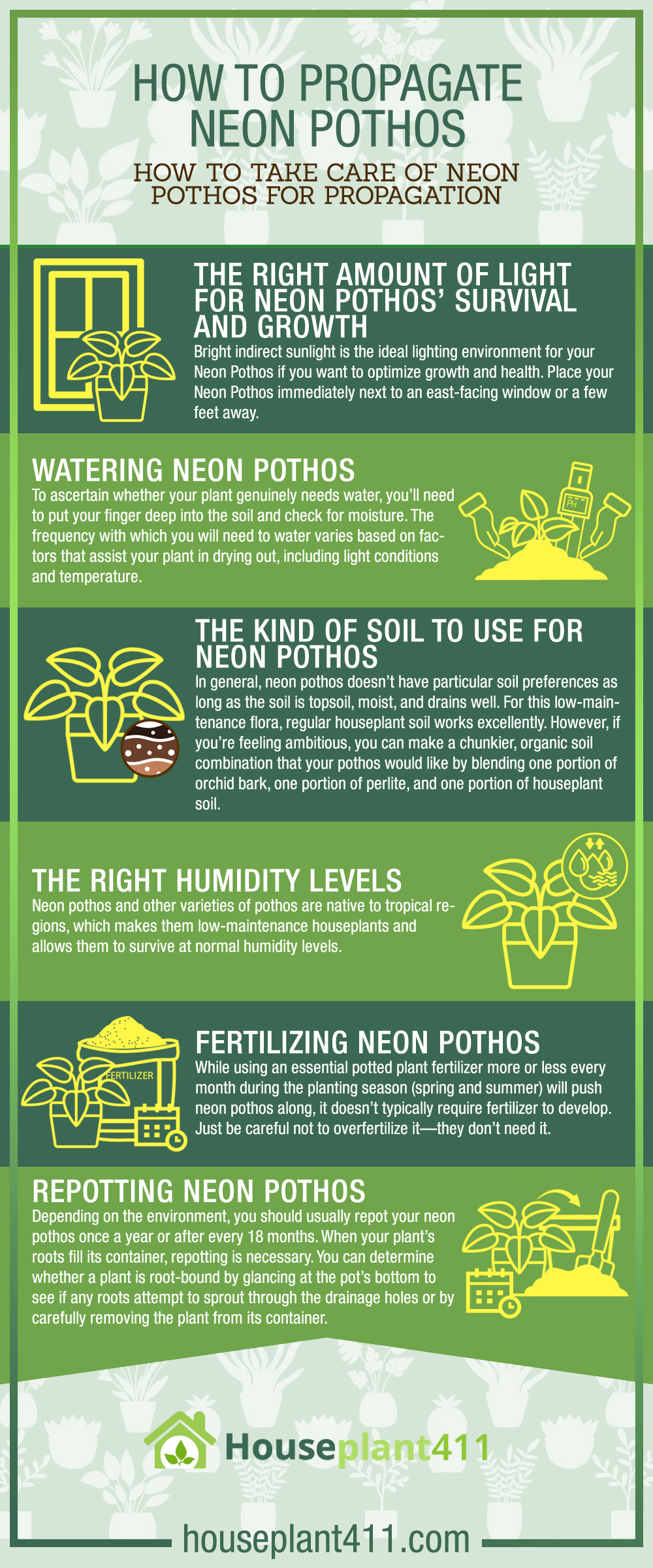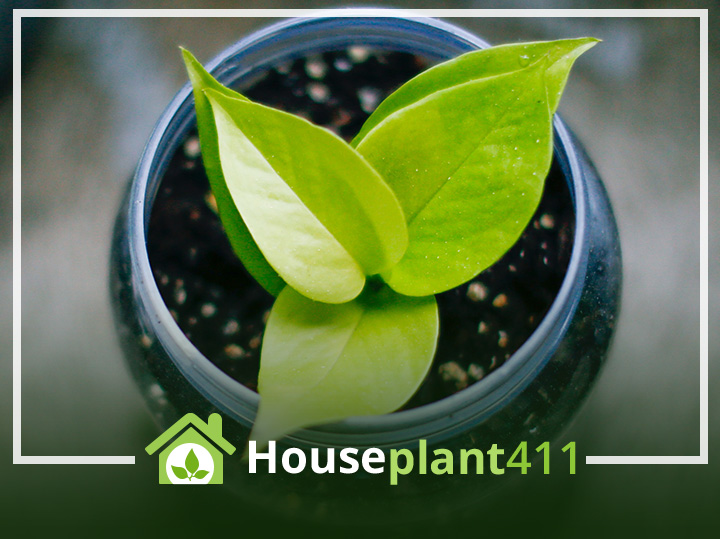Neon pothos, one of the most popular and dazzling types of pothos, are easy-to-handle houseplants guaranteed to uplift any room in your house.
This exquisite type of pothos, indigenous to the Solomon Islands, stands out for its vining growth pattern, leaves shaped like a heart, and neon-green appearance. The best thing is that neon pothos are easy to care for, which makes them perfect for novice gardeners or people with a reputation for having brown thumbs.
Your home or business will look much more vibrant and intriguing with neon Pothos plants. You might be asking, “How can I care for a neon pothos and develop them into a lot more plants” now that you’ve bought one?
Fortunately, if you understand a few fundamentals, neon pothos care and propagation are relatively simple. If you adhere to the simple care and propagation guidelines in this article, you can maintain the health of your neon pothos while producing other neons from them.
How to Take Care of Neon Pothos for Propagation
These vibrant pothos require little upkeep and are simple to look after. They can adjust to various lighting situations, and while they benefit from routine watering, they recover quickly if you occasionally fail to water them.
While pruning is not essential for these tropical vines when planted inside, neon pothos can produce up to ten feet long, so you may want to cut the vines occasionally to keep their growth under control. The following tips help you better care for neon pothos, whether your goal is ensuring their long life or propagating them.
The Right Amount of Light for Neon Pothos’ Survival and Growth
Numerous lighting setups are suitable for growing neon pothos. The lighting you use genuinely depends on the results you want from your neon pothos plant.
Bright indirect sunlight is the ideal lighting environment for your Neon Pothos if you want to optimize growth and health. Place your Neon Pothos immediately next to an east-facing window or a few feet away.
Your plant doesn’t mind if it gets a few hours of direct sunlight. Ensure the sun isn’t directly overhead for most of the day when tending to your pothos. Pothos thrives in a rainforest canopy. Thus dappled sunshine is the ideal location for it. Thus, the leaves can be burned by excessive direct sunlight.
The finest atmosphere we can create is light through a window, even though we cannot have dappled sunshine inside our dwellings. Neon Pothos can develop quite quickly in these lighting settings, as well. from a west-facing window to achieve these lighting conditions.
This plant can also thrive in mild, indirect light if you’re not concerned about the Neon Pothos’ growth potential or need access to a location with bright indirect light. It would be closer to a window or a window facing north.
In moderate light, the neon pothos plant may grow a little more slowly and develop a little lankier stem, but it will still be in good health. Note that under these lighting conditions, the plant will require less water. It’s because photosynthesis, which uses less water when there is less light, will proceed more slowly.
Therefore, it is possible to overwater a pothos that needs more light. However, your plant will remain healthy if you heed the watering guidance I provided later in this post and only water when the soil is dry.
Neon Pothos is a fast-growing plant, so even though the development could be a little slower in a modest light, it will still be apparent.
The south-facing window in your home will, at last, receive the most sunlight. Most of the day, these windows receive direct sunshine, which is unsuitable for pothos plants.
Watering Neon Pothos
However, some individuals also suggested letting them dry out in between waterings. Most individuals typically water their pothos plants once they are dry, around two inches down.
To ascertain whether your plant genuinely needs water, you’ll need to put your finger deep into the soil and check for moisture. The frequency with which you will need to water varies based on factors that assist your plant in drying out, including light conditions and temperature.
Pothos are pretty hardy plants that withstand dry and mild overwatering. Be careful to water them sparingly, as this could cause root rot in your plant.
The Kind of Soil to Use for Neon Pothos
In general, neon pothos doesn’t have particular soil preferences as long as the soil is topsoil, moist, and drains well. For this low-maintenance flora, regular houseplant soil works excellently. However, if you’re feeling ambitious, you can make a chunkier, organic soil combination that your pothos would like by blending one portion of orchid bark, one portion of perlite, and one portion of houseplant soil.
The Right Humidity Levels
Neon pothos and other varieties of pothos are native to tropical regions, which makes them low-maintenance houseplants and allows them to survive at normal humidity levels.
Your neon pothos will thrive in any temperature between 15 and 35 degrees Centigrade (or 55 to 90 degrees F). For this pothos, the average indoor humidity is also sufficient, though adding more moisture (with a pebble tray or humidifier) will promote more healthy growth.
Fertilizing Neon Pothos
While using an essential potted plant fertilizer more or less every month during the planting season (spring and summer) will push neon pothos along, it doesn’t typically require fertilizer to develop. Just be careful not to overfertilize it—they don’t need it.
Repotting Neon Pothos
Depending on the environment, you should usually repot your neon pothos once a year or after every 18 months. When your plant’s roots fill its container, repotting is necessary. You can determine whether a plant is root-bound by glancing at the pot’s bottom to see if any roots attempt to sprout through the drainage holes or by carefully removing the plant from its container.
Refrain from repotting your pothos in the fall if you reside in a region with extremely cold or severe winters. These plants want to be left alone because they typically become dormant in winter. For optimal results, repot when necessary in the spring or summer.

FAQs about Propagating Neon Pothos
Before we get to the steps in propagating neon pothos, let’s know the answers to some frequently asked questions (FAQs) related to the process. Here are those FAQs about propagating neon pothos and their answers.
How Much Time Is Need For Neon Pothos to Root in Water?
In around two weeks, the first signs of roots should appear. Before you plant your plants in soil, allow about two months to develop and grow roots about 2-3 inches long.
Is Grow Neon Pothos in Water Possible?
Pothos can be easily rooted in water. But, if you transplant them into the soil, wait until the roots are at most 3 inches long.
Is It Possible to Propagate Neon Pothos in Soil?
For pothos, soil propagation is identical to water propagation; all you need to do is keep the soil moist. We advise making a greenhouse effect by draping a plastic bag gently over the pot.
Since root development may be easily observed, we recommend water propagation. Pothos can also be multiplied in LECA or sphagnum moss.
What Is the Best Season For Propagating Neon Pothos?
Pothos roots quickly during the summer and spring growing seasons. But you can successfully multiply indoor plants all year long. Place them indoors in indirect sunshine.
How Much Time Is Need For Neon Pothos to Propagate in Water?
Cuttings of pothos take around two months to grow fully in water.
When Is The Right Time To Move Cuttings of Pothos From Water to Soil?
When the roots of your cutting are about two inches long, plant it in the ground. Put it somewhere with bright indirect light and watch it grow!
Is Propagating Neon Pothos Without Leaves Possible?
It is possible to propagate pothos stem pieces without leaves effectively. They will gradually sprout new leaves after you place them in the soil.
What Is the Right Place to Cut Pothos for Propagation?
Cuttings should be between six and eight inches long. Pick a vigorous branch of the plant, ideally actively regenerating new growth. Remove a few of the nodes (tiny brown mounds where leaves develop) because roots will grow from them.
The tip of your cutting will have roots if you make your cut with a node at the bottom. It indicates that the mother plant’s last section past the node will turn brown and eventually die, while the final node will produce new growth.
You can also cut right before a leaf node such that the node is the only part of the mother plant left. It will cause new growth to appear precisely where the mother plant was cut, but the roots on the fresh cutting will be slightly higher. Ensure your water container is deep enough to maintain the node’s submersion.
The Steps for Propagating Neon Pothos
Like other pothos variations, neon pothos is simple to grow from stem cuttings. By replanting the cuttings in the parent pot, you can produce a fuller-looking plant by reusing any pruning cuts you may have taken. Alternatively, you can propagate fresh plants from the cuttings to give to friends.
To grow your neon pothos from stem cuttings, you need to follow the steps below:
- Trim the stem of your neon pothos leaf an inch higher and lower than the node. For propagation, you’ll need a minimum of one node. Depending on the container size you intend to use, we suggest doubling the number of node cuts if you want a plant that looks highly full. For instance, cut a minimum of eight leaf nodes if you use a 4-inch pot. A minimum of twelve leaf nodes must be removed for a 6-inch pot. The same procedure can be used with a cutting that contains several leaf nodes.
- Insert the cut tips into a small container of water for propagation. Ascertain if the level of water is high enough to cover the nodes. The cuttings should be kept in intense indirect light. Avoid exposing the cutting to direct sunlight, and in just a month, you should notice new root development from the nodes; the roots will be suitable for planting in soil once they grow an inch or two long. Use the soil mixture we discussed above.
- Ensure the soil is moist for the initial month after planting the rooted node cuts so your plant can get used to the change from water to the soil. After that, you may take care of it like any other pothos and wait a while before watering it again. Ultimately, every leaf node you planted will begin to produce new stems and leaves.
- You can perform the first step for soil propagation, then ignore step 2 and put the cuts in the ground instead. Till the cuttings begin to grow roots, keep the soil moist. Utilizing the water propagation procedure first will lead to better results, with most or all nodes surviving. Although soil propagation also works, some nodes will almost always fail.
Stay calm about the cuttings you take from your parent plant. Your parent plant’s clipped stems won’t be impacted by the pruning and will continue to produce new growth since new growth will emerge from the node above where you cut.
Final Word
Neon pothos is no exception to the rule that pothos generally multiply. It’s one of the explanations for people’s ongoing affection for this species. Neon Pothos can grow many feet in a year if you follow the care recommendations and steps for propagation mentioned in this post. Happy Propagating!

